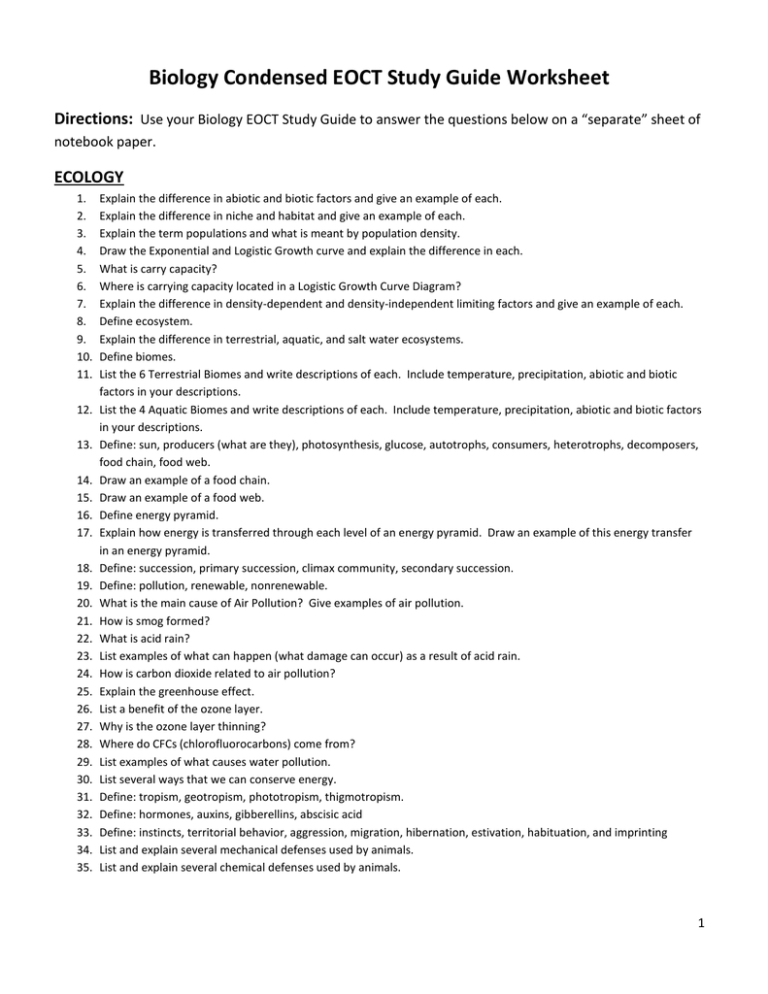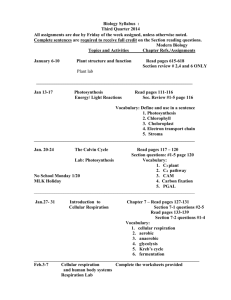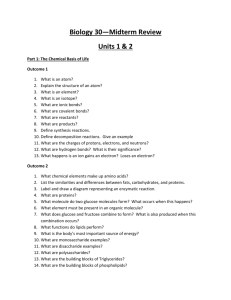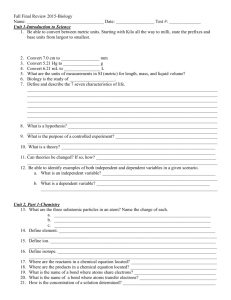Condensed EOC Study Guide Created by Mrs. Silver Worksheet
advertisement

Biology Condensed EOCT Study Guide Worksheet Directions: Use your Biology EOCT Study Guide to answer the questions below on a “separate” sheet of notebook paper. ECOLOGY 1. 2. 3. 4. 5. 6. 7. 8. 9. 10. 11. 12. 13. 14. 15. 16. 17. 18. 19. 20. 21. 22. 23. 24. 25. 26. 27. 28. 29. 30. 31. 32. 33. 34. 35. Explain the difference in abiotic and biotic factors and give an example of each. Explain the difference in niche and habitat and give an example of each. Explain the term populations and what is meant by population density. Draw the Exponential and Logistic Growth curve and explain the difference in each. What is carry capacity? Where is carrying capacity located in a Logistic Growth Curve Diagram? Explain the difference in density-dependent and density-independent limiting factors and give an example of each. Define ecosystem. Explain the difference in terrestrial, aquatic, and salt water ecosystems. Define biomes. List the 6 Terrestrial Biomes and write descriptions of each. Include temperature, precipitation, abiotic and biotic factors in your descriptions. List the 4 Aquatic Biomes and write descriptions of each. Include temperature, precipitation, abiotic and biotic factors in your descriptions. Define: sun, producers (what are they), photosynthesis, glucose, autotrophs, consumers, heterotrophs, decomposers, food chain, food web. Draw an example of a food chain. Draw an example of a food web. Define energy pyramid. Explain how energy is transferred through each level of an energy pyramid. Draw an example of this energy transfer in an energy pyramid. Define: succession, primary succession, climax community, secondary succession. Define: pollution, renewable, nonrenewable. What is the main cause of Air Pollution? Give examples of air pollution. How is smog formed? What is acid rain? List examples of what can happen (what damage can occur) as a result of acid rain. How is carbon dioxide related to air pollution? Explain the greenhouse effect. List a benefit of the ozone layer. Why is the ozone layer thinning? Where do CFCs (chlorofluorocarbons) come from? List examples of what causes water pollution. List several ways that we can conserve energy. Define: tropism, geotropism, phototropism, thigmotropism. Define: hormones, auxins, gibberellins, abscisic acid Define: instincts, territorial behavior, aggression, migration, hibernation, estivation, habituation, and imprinting List and explain several mechanical defenses used by animals. List and explain several chemical defenses used by animals. 1 CELLS 36. Explain the differences in prokaryotes and eukaryotes. Give examples of each. 37. Explain the functions of the following organelles: nucleus, chloroplasts, golgi bodies, mitochondria, ribosomes, cell membranes, cell wall. 38. Define homeostasis. 39. Which of the following requires energy? Passive transport or active transport? 40. Define passive transport. 41. List three types of passive transport. 42. Explain diffusion, osmosis, and facilitated transport (facilitated diffusion). 43. Define active transport. 44. Explain endocytosis and exocytosis. 45. Define enzymes. 46. List 3 characteristics of enzymes. 47. Define: substrates, products, active site, and activation energy. 48. What is RNA polymerase? 49. List the FOUR major macromolecules. 50. Write descriptions for: carbohydrates, lipids, proteins, and nucleic acids. 51. Define diffusion. 52. Define osmosis. ORGANISMS 53. 54. 55. 56. 57. 58. 59. 60. 61. 62. 63. 64. 65. 66. 67. 68. 69. 70. What is ATP? ATP has how many phosphate groups? ADP has how many phosphate groups? Define: autotrophs, chlorophyll, chloroplasts, stroma, and grana and photosynthesis. What is the equation for photosynthesis. Explain what happens in “The Light Reaction” of Photosynthesis. Explain what happens in “The Dark Reaction” or Calvin Cycle of photosynthesis. Define cellular respiration. What is the equation for cellular respiration. Compare the equations for cellular respiration and photosynthesis. List and explain the TWO main reactions of Cellular Respiration. What is glycolysis? The order of Cellular Respiration is as follows: Glycolysis Krebs Cycle Electron Transport Chain. Copy the transitions that occur (part with arrows below the three parts listed above). List the Six Kingdoms and provide a description for each one. Define taxonomy and taxonomist. What are the 7 levels of classification? Define virus. Are viruses living or nonliving? What must a virus do in order to reproduce? GENETICS 71. 72. 73. 74. 75. What is genetics? What makes up a nucleotide? What are the four nitrogen bases of DNA? What is DNA replication? Where is DNA located in Eukaryotic cells? 2 76. 77. 78. 79. 80. 81. 82. 83. 84. 85. 86. 87. 88. 89. 90. 91. 92. 93. 94. 95. 96. 97. 98. 99. Where is DNA located in Prokaryotic cells? Is DNA double stranded or single stranded? Is RNA double stranded or single stranded? What is transcription? Where does transcription occur in the cell? Which RNA is used in transcription? What is translation? Where does translation occur in the cell? Which organelle is used during translation? What RNA is used in translation? Define codon. Define anticodon. Define: dominant, recessive, alleles, genotype, phenotype, homozygous, heterozygous, monohybrid, dihydrid and Punnett square. What type of reproduction is mitosis? What happened when Mendel crossed Tall plants with short plants? What happened when he allowed the F1 (plants from cross above) plants to self-pollinate? Explain the Law of Dominance, the Law of Segregation, and the Law of Independent Assortment. What is produced during meiosis? What happens during meiosis 1 and meiosis 2? Define: crossing over, genetic recombination, DNA gene mutations, mutagens, spontaneous mutations, base pair substitutions, base insertion, base deletion. List three advantages of asexual reproduction. Is the offspring identical of different in asexual reproduction? List three advantages of sexual reproduction. List a disadvantage to sexual reproduction. Explain the advances that are used with DNA technology in: medicine, forensics, agriculture, and genetic engineering. EVOLUTION 100. What did Lamarck contribute to the theory of evolution? 101. Explain the information that influenced Darwin’s view of natural selection/ evolution. 102. Define adaptation. 103. Define natural selection. 104. List 3 modes of evolution and give a description of each. 105. What is biodiversity? 106. Explain the difference in ecosystem, species, and genetic diversity. 107. What are molecular clocks? 108. What is speciation? 109. What is geographic isolation? 110. What is gradualism? 111. What is punctuated equilibrium? 112. List the scientific evidence that supports the theory of evolution. 113. What is radioisotope dating? 114. What is relative dating? 115. Define fitness and variation. 116. Explain natural, stabilizing, directional, and disruptive selection. 117. Explain viruses ability to evolve. 118. Define accuracy and precision. 119. Write the steps to the scientific method. 3






